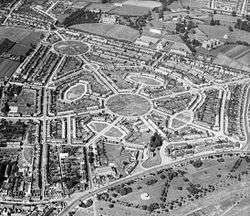Marino, Dublin
| Marino Irish: An Mairíne | |
|---|---|
| Suburb | |
 Aerial photograph taken shortly after the construction of Marino | |
 Marino Location in Ireland | |
| Coordinates: 53°21′54″N 6°13′48″W / 53.365°N 6.23°WCoordinates: 53°21′54″N 6°13′48″W / 53.365°N 6.23°W | |
| Country |
|
| Province | Leinster |
| County | Dublin |
| Council | Dublin City Council |
| Dáil Éireann | Dublin Bay North |
| European Parliament | Dublin |
| Elevation | 4 m (13 ft) |
Marino (Irish: An Mairíne) is an inner suburb located on the northside of Dublin, Ireland.
Location and access
Marino roughly encompasses the area within the boundaries of Sion Hill Road, Gracepark Road, Philipsburgh Avenue (north of Lynch's, Malahide Road and Shelmartin Terrace. Marino borders other Northside areas such as Fairview, Donnycarney and Clontarf. It is two kilometres from the GPO in O'Connell Street.
The area is served by the Clontarf Road DART station.
Dublin Bus operates route 123 through Marino, with other routes passing around the edges.
History
The townland of Marino was carved out of the townland of Donnycarney which was granted to the Corporation of Dublin following the dissolution of The Priory of All Hallows in the reign of King Henry VIII. In 1787, it was described by English writer Richard Lewis as "a small village a mile beyond Drumcondra and two-and-a-half miles from Dublin Castle."
The estate was built on the site of a planned formal garden for Marino House and the original design was followed when the streets were laid out. This gives Marino its symmetrical layout.
When it was first built, purchases of houses was restricted to large families. While alcohol, dogs without leads and children after dark were banned from the parks.
The well known Casino was built in 1759 as a summer house in the grounds of Marino House, demolished in the 1920s. A tunnel linking it to the main house for servants' use is where Michael Collins and his men carried out tests with their first Thompson sub-machine gun. The Asgard guns are believed to have been hidden here. The are was full of members of the Irish Citizens'. Jim Larkin lived in Croydon Park House and Countess Markiewicz and James Connolly were frequent visitors.
The area was developed for housing in the late 1920s and 1930s on the former estate lands of the Earl of Charlemont in the civil parish of Clonturk (now Marino, Fairview and Drumcondra). It is notable as one of the first examples, in the newly formed Irish state, of an affordable housing project and was the first local authority housing estate in the country. It is heavily influenced by the garden city movement.
The area consists of about 1,300 houses built for the most part of concrete, which was an unusual building material at that time in Ireland. The scheme was designed by Frederick Hicks and H.T. O'Rourke[1] and the houses were built by a private contractor using a proportion of immigrant German builders.[2] The houses each cost £657 to build (approximately €40,000 at today's costs ).[3],but were bought for prices as cheap as £25.
The development centred on a large circular 'green', Marino Park, with adjoining symmetrical green areas such as Marino Green, the green area in the middle of Croydon Park Avenue is known locally as the "D" walls, that give the area a highly distinctive character when seen from the air.
Amenities
Marino is home to well regarded schools including St. Vincent de Paul Infants and Girls National School, Scoil Mhuire CBS and Ard Scoil Rís Secondary School which are all located on Griffith Avenue, next to the Parish Church.
Along Philipsburgh Avenue there is a strip of shops that serve the local people of Marino including a hairdressers, dry cleaners, butchers, C&T Superstore, Pharmacy and Bakery.
Marino is home to the renowned St Vincents GAA Club, based at Pairc Naomh Uinsionn just off the Malahide Road, bordering Donnycarney. St Vincents has produced many notable football and hurling players over the years. The club fields very successful senior sides and has a thriving juvenile section which caters for close to one thousand boys and girls.
Marino AFC plays soccer on one of the greens.
Marino/Fairview CY/LYMC is a pitch and putt and social club on Philipsburgh Avenue.
Carlton Hall Community Centre located on Shelmartin Avenue provides the local community with many facilities including karate, mother and baby classes etc.
The Order of Malta Ambulance Corps has a unit in Marino which provides first aid cover to local events. The current Officer in Charge of the unit is Jean Hoban.
The Casino at Marino
The Casino is a famous piece of Irish neo-classical architecture. It was designed by William Chambers as a pleasure house for James Caulfeild, 1st Earl of Charlemont. It is regarded as one of the finest 18th century neo-classical buildings in Europe. The Casino, meaning "small house", contains a total of 16 finely decorated rooms. It is maintained by the Office of Public Works and is open to the public annually from April to October, with an admission charge.
Religion
Marino is a parish in the Fingal South East deanery of the Roman Catholic Archdiocese of Dublin. It is served by the Church of St Vincent de Paul.[4]
References
- ↑ "HICKS, FREDERICK GEORGE". Dictionary of Irish Architects 1720 - 1940. Irish Architectural Archive. Retrieved 10 May 2017.
- ↑ EMPLOYMENT OF ALIENS IN SAORSTAT, Dail Questions, 13 November, 1925 Archived 2007-03-11 at the Wayback Machine.
- ↑ Irish Senate Debate, LOCAL GOVERNMENT BILL, 1926, 23 February 1927 Archived 11 March 2007 at the Wayback Machine.
- ↑ Official website - Marino parish